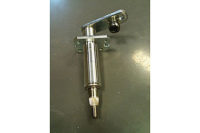Both Lear Corp. and Hyundai Motor Manufacturing have found a manufacturing home in Montgomery, AL. Lear operates a plant that makes and delivers seats to the nearby Hyundai plant for just-in-time installation in Sonata sedans and Sante Fe SUVs. About two hours before the seats need to be installed, Lear receives a live broadcast of the exact production sequence and seat model requirements from Hyundai.
The Lear plant—which won the ASSEMBLY Plant of the Year award in 2006—builds about 1,000 seat sets per day or 73 sets per hour in 56 distinct combinations of colors and options. Seats are assembled on pallets with fixtures that rotate and tilt to maximize worker accessibility.
Each of the plant’s four assembly lines features a nonsynchronous looping conveyor with timed stopping at each workstation. The conveyor is linked to a PC-based quality assurance system that monitors seat assembly and verifies proper sequencing.
Made by Integrated Systems Design, this system uses RFID tags, antennas and chips. A read-only RFID tag is attached to each seat. An RFID antenna is located at each quality assurance station to read RFID chips embedded in the seat build fixtures.
As a seat set moves down the conveyor, the quality assurance system electronically displays instructions for workstation operators to provide positive seat identification and data tracking. The system then receives various tool, equipment and operator inputs and determines whether a seat assembly or component passes or fails. Defective seats are automatically routed to a repair station.
Equally important, the system lets operators thoroughly track internal defects and tells them the specific assembly workstation where a defect occurred. Once a “work complete” message appears on the workstation display screen, an operator can release the part he is working on and allow it to move to the next process.
After a seat set passes inspection, it is placed on a shipping pallet, wrapped in a plastic bag, labeled with a bar code, and transferred to the shipping area. An automated storage and retrieval system (ASRS) reads the bar code to determine where each pallet is stored in the shipping area.
Lear software directs the ASRS to sequence all pallets in reverse broadcast order prior to loading on a semitrailer. This ensures that each set is delivered in the correct sequence to the assembly line when the appropriate vehicle reaches the seat-install workstations.
Lear also uses an RFID-based outbound shipping sequence control system. A chip is mounted to the rear of each Lear semitrailer. Antennas are located on Lear’s shipping dock and Hyundai’s receiving dock.
Each semitrailer holds 54 pallets, which can be automatically loaded on a semitrailer in less than 1 minute. Following loading, sequence information is written to the RFID chip on the semitrailer. This information is then checked to ensure that the write is successful. The sequence control system will not allow the truck dock lock to be unlocked unless the data has been written successfully to the chip.
When the truck backs into Hyundai’s dock, the chip attached to the rear of the semitrailer is read. If the sequence is incorrect, an alarm horn and beacon are activated, and Hyundai employees cannot unload the truck.
If the sequence information is correct, the control system allows workers to initiate the unload sequence. An automated system moves each seat set from the dock to the assembly line.
For more information on RFID-based monitoring systems, call 248-668-8250 or visit www.isddd.com.





